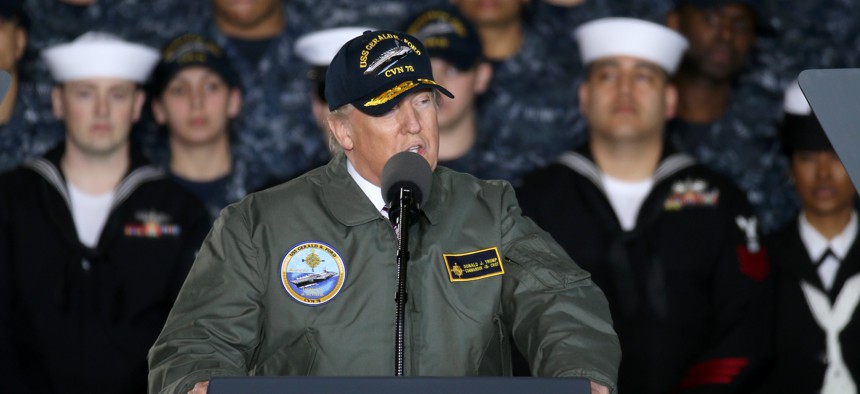
President Donald Trump visits the precommissioning unit Gerald R. Ford (CVN 78) in March 2017. U.S. Navy / Mass Communication 1st Class Joshua Sheppard
Trump Wants ‘Goddamned Steam,’ Not Digital Catapults on Aircraft Carriers
The president's criticism of the USS Ford's EMALS 'blindsided' Navy officials.
Navy officials were “blindsided” on Thursday, a spokesman told me, by President Donald Trump’s suggestion that he has convinced the Navy to abandon a long-planned digital launching system in favor of steam on its newest aircraft carrier.
In a wide-ranging interview with Time magazine, Trump described his disgust with the catapult system known as Electro-Magnetic Aircraft Launch System, nicknamed EMALS, aboard the USS Gerald R. Ford. (Time has published only excerpts from the interview, not a full transcript.) The president described wanting to scrap EMALS, a key technological upgrade at the center of the multibillion-dollar carrier project, and return to steam.
I said, “You don’t use steam anymore for catapult?” “No sir.” I said, “Ah, how is it working?” “Sir, not good. Not good. Doesn’t have the power. You know the steam is just brutal. You see that sucker going and steam’s going all over the place, there’s planes thrown in the air.”
It sounded bad to me. Digital. They have digital. What is digital? And it’s very complicated, you have to be Albert Einstein to figure it out. And I said—and now they want to buy more aircraft carriers. I said, “What system are you going to be—” “Sir, we’re staying with digital.” I said, “No you’re not. You going to goddamned steam, the digital costs hundreds of millions of dollars more money and it’s no good.”
Despite Trump’s technological leanings—he’s TV-obsessed, he was a semi-early adopter of the web, and he has a preternatural sense for Twitter drama—his question about “digital” calls to mind his cluelessness about “the cyber.”
It’s not that EMALS has been a smashing success. Cost and schedule overruns have given the Navy carrier project a reputation for being "one of the most spectacular acquisition debacles in recent memory,” as Senator John McCain, the Arizona Republican, put it in 2015. “And that is saying something.” The construction of three Ford-class aircraft carriers has swelled from $27 billion to $36 billion in the last 10 years.
But the problems with the Ford-class carrier program are more organizational than technological—a common theme among infrastructural megaprojects. McCain blamed “misalignment of accountability and responsibility in our defense acquisition system” and the vast bureaucracy of defense acquisition systems, which span multiple offices and program managers.
Trump seems to have seized on the project’s bad reputation without appreciating—or at least without clearly articulating—the complexities of moving from steam to digital.
The steam-powered catapult systems that are being replaced have been used to launch airplanes from U.S. carriers for some six decades now. Not only are steam systems are harder to maintain than electrical ones; they have a lower upper-limit during combat—meaning electrical systems can launch more aircraft in a shorter amount of time. Electrical systems can also better handle smaller aircrafts and drones compared with steam. Steam systems also put more stress on airframes, and make them more prone to corrosion. Not only that, but carriers themselves are exceedingly vulnerable to attack—meaning outfitting them with the modern defense systems is a priority.
The goal for the upgraded system is to use carriers to create “an operational honeycomb of interconnected forces with reach, range and lethality against air, sea, space, and land-based targets,” as Robbin Laird and Ed Timperlake wrote for the website Breaking Defense in 2015.
Despite some high-profile failures in early testing, EMALS is now nearly complete and ready for sea trials. It represents one of three major initiatives in the Navy’s push to go upgrade its weapons systems for the digital era.
Trump’s insistence on steam is perhaps bewildering, but also consistent with some of his other views about technology. After all, the president has repeatedly talked about returning to America’s golden age of manufacturing—an idea that’s laughable, if regrettable, to anyone who has looked closely at the forces driving the global economy. Among them: the rise of automation, which promises to dramatically transform the way humans work across multiple industries, and which Trump has all but ignored.
Then again, for a man who is clearly concerned with hugeness, you’d think Trump might appreciate EMALS: In working order, the system can launch anything from the sleekest drone to the sturdiest F-35, and it blasts through the technological limits imposed by steam. Trump has demonstrated a fondness for super carriers, and has said he plans to increase the U.S. fleet from 10 to 12.
He hasn’t, however, indicated how he plans to pay for that. The cost of a single new, Ford-class carrier—about $11 billion without cost overruns—would eat up nearly 20 percent of Trump’s proposed defense budget increase, Reuters reported in March.
The Navy says it is scrambling to figure out how to address the president’s concerns. A spokesman said it will issue a statement on Thursday afternoon, and figure out talking points for Naval leaders should the question come up at public events.
In the meantime, Trump might do well to worry more about the signature infrastructure promise of his own campaign, than a near-complete military project he doesn’t seem to understand.



